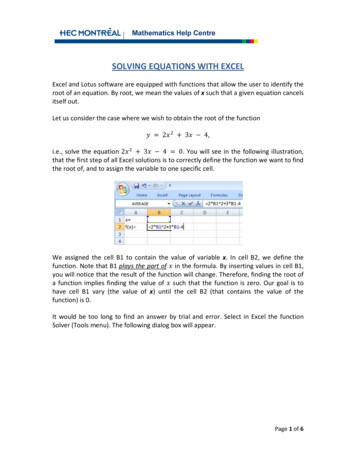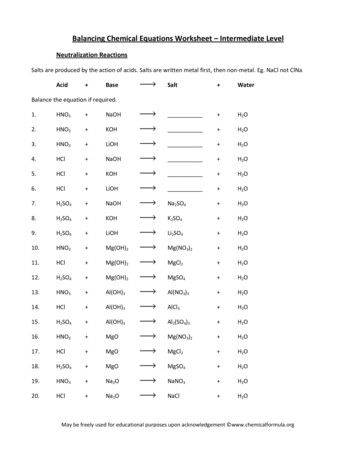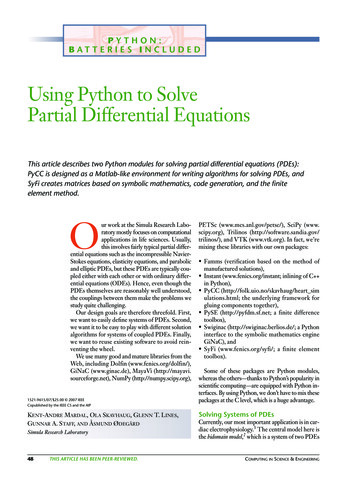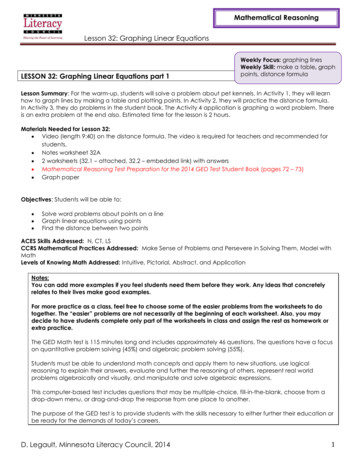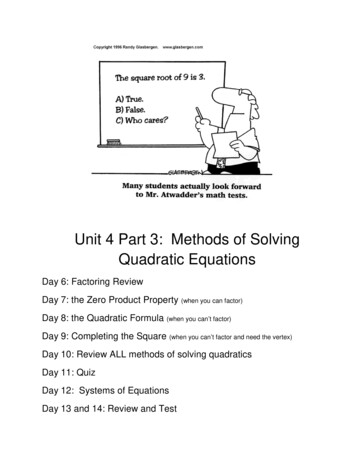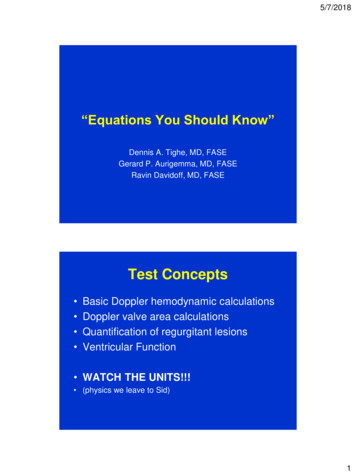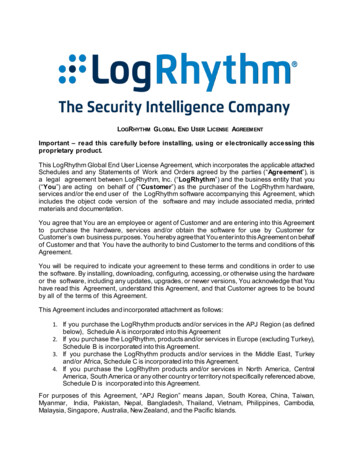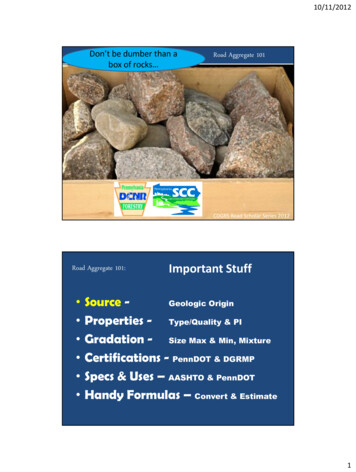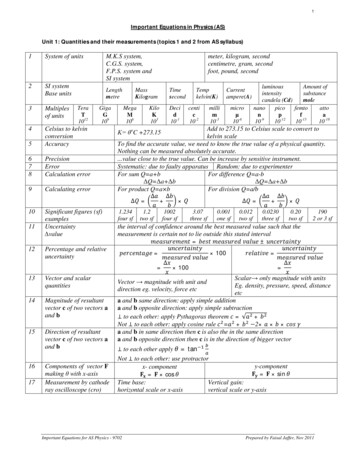
Transcription
1Important Equations in Physics (AS)Unit 1: Quantities and their measurements (topics 1 and 2 from AS syllabus)1System of units2SI systemBase units3Multiplesof units45Celsius to on error9Calculating error10Significant figures (sf)examplesUncertainty value1112M.K.S system,C.G.S. system,F.P.S. system andSI systemLengthmetreTeraT1012GigaG109meter, kilogram, secondcentimetre, gram, secondfoot, pound, secondMassKilogramMegaM106KiloK10314Magnitude of resultantvector c of two vectors aand b15Direction of resultantvector c of two vectors aand b1617Components of vector Fmaking θ with x-axisMeasurement by cathoderay oscilloscope -6luminousAmount ofintensitysubstancecandela d to 273.15 to Celsius scale to convert tokelvin scaleTo find the accurate value, we need to know the true value of a physical quantity.Nothing can be measured absolutely accurate.value close to the true value. Can be increase by sensitive instrument.Systematic: due to faulty apparatus Random: due to experimenterFor sum Q a bFor difference Q a-bΔQ Δa ΔbΔQ Δa ΔbFor product Q a bFor division Q a/b 1.234four sf1.2two sf1002four sf3.07three sf0.001one sf0.012two sf0.0230three sf0.20two sf1902 or 3 sfthe interval of confidence around the best measured value such that themeasurement is certain not to lie outside this stated interval Vector and scalarquantitiesDecid10-1Tempkelvin(K)K θoC 273.15Percentage and relativeuncertainty13Timesecond 100 100 Scalar only magnitude with unitsEg. density, pressure, speed, distanceetca and b same direction: apply simple additiona and b opposite direction: apply simple subtraction to each other: apply Pythagoras theorem Not to each other: apply cosine rule 2 a and b in same direction then c is also the in the same directiona and b opposite direction then c is in the direction of bigger vectorVector magnitude with unit anddirection eg. velocity, force etc to each other apply tanNot to each other: use protractory-componentx- component sin cosTime base:Vertical gain:horizontal scale or x-axisvertical scale or y-axisImportant Equations for AS Physics - 9702Prepared by Faisal Jaffer, Nov 2011
2Unit 2: Motion, force and energy (topic 3, 4, 5 and 6 from AS syllabus)1Average velocity ̅23Instantaneous velocityAverage acceleration4Acceleration and velocity5Graphical representation6Speed-time graph78Distance-time graphEquation for uniformmotion, constant motion9 Equations for uniformlyaccelerated motion- body start motion u 0- body come to rest v 0- free fall g a 9.81ms-2- horizontal motion s x- vertical motion s h y10 Friction static anddynamic11 Air resistance or viscousforce or viscous drag12 Terminal velocity13 Projectile:Motion in two dimensions,v and angle θ withhorizontal, upward is 14 Weight and mass:weight is force of gravity,mass is the amount ofmatter, it never changes15 Stability of an object16 Momentum17 Conservation of linearmomentum18 Elastic collision19 Elastic collisionImportant Equations for AS Physics - 9702s is the displacement in meters and tis the time in seconds.Velocity of an object at any particular instant of time. Δv is the change of speed and Δt is the change of time. Unit of acceleration is ms-2Same direction: acceleration is ve (if velocity is in ve direction)Opposite direction: acceleration is -ve, deceleration, retardation̅ Area under the graph: distance covered by and objectGradient of the graph: accelerationGradient of the graphs: speed of an objectonly use when acceleration 0 and no net force is appliedv is the final velocity in ms-1, ( )u is the initial velocity in ms-1, s is the distance/displacement in m,21a is the acceleration in ms-2 and t is the time in s.2 2fs is the static friction in newton,Static fk is the dynamic friction in newton,Dynamic µs is the coefficient of static frictionN is the reaction or normal forceµk is the coeff. of dynamic frictionperpendicular to the surface- Opposing force to the motion in presence of air or fluid- During free fall in the beginning: weight air resistance upthrust- Later: weight resistance upthrust- at terminal velocity, weight air resistance upthrustx-component y-component horizontal rangeno accelerationacceleration is g 2 cos sin cos ½max range at θ 45ow is the weight in newton (N), m isthe mass in kg and g is acceleration due to gravity 9.81 ms-2Lower the centre of gravity more stable the object isWider the base of an object more stable the object isMomentum mass velocityunit is kg.m.s-1 or N.sp m vTotal momentum before collision total momentum after collision Total kinetic energy before collision total kinetic energy after collision½ ½ ½ ½for two masses or the equation must satisfy Prepared by Faisal Jaffer, Nov 2011
320 Inelastic collision21 Newton’s first law ofmotion22 Newton’s second law ofmotion23 Newton’s third law ofmotion24 Momentum and 2nd law ofmotion25 Impulse26 Density ‘ρ’ in kgm-3 orgcm-3Total kinetic energy before collision total kinetic energy after collision½ ½ ½ ½Object in motion stay in motion foreverobject stationary stay stationary foreverunless force applied- Net force applied acceleration - Mass of an object 1/acceleration 1 -1 N is the amount of force require to create an acceleration of 1 ms-2 of mass of 1 kg; k 1Nkg-1m-1s2Action and reaction forces applied by two objects on each other is alwaysequal in magnitude and opposite in directionRate of change of momentum is equal to the net force applied m is the mass and V is the volume27 Pressure p in pascal (Pa) 28 Pressure in fluids due todepth h in meters29 Upthrust:- upward force applied byfluid on an object30 Measuring the density ofliquid using (upthrust) Archimedes principle31 Torque or moment offorce32 Torque due to a couple ortwo equal forces33 Conditions of equilibrium34 Work :ΔW is the work in joules35 External work done by anexpanding gas35 Work done in stretching aspring36 Principal of conservationof mechanical energy37 Electrical potentialenergy:Work done in bring theunit positive charge frominfinity to a point.Important Equations for AS Physics - 9702ℎℎ ℎ* upthrust is equal to the weight of theliquid displaced sinConstant force acting for short time- ρ of Mercury is 13.6gcm-3- ρ of water is 1gcm-3 at 4oC- ρ of air 0.001293gcm-3F is the force in N and A is the areaon which the force applied in m2ρ is the density of the fluid, g is theacceleration due to gravity and h isthe height or depth in metre- Object floats if the density of objectis less than or equal to the density ofthe fluid and object sinks if thedensity of object is more than thedensity of fluidℎℎF applied perpendicular to dCouple one force perpendicular distance between the two forces -Total or net force applied is zeroΣ 0-Total torque applied is zeroΣ 0F is the force, s is the displacement cosin the direction of the force appliedwork that causes motion Ekand θ is the angle between F and swork that store energy Epp is the pressure in Pa and ΔV is the In p-V graph the area under the graph expansion of gas in m3is the work doneF is the force applied and x is the ½ ½extensionWork area under the F-x graphLoss of gain or Ep gain or loss of EkΔ Δℎ ½q is the quantity of charge in, coulomb and V is the potentialdifference between the points.Prepared by Faisal Jaffer, Nov 2011
438 Internal energy:Sum of the Ek and Ep ofthe molecules of a system39 Power 40 Efficiency of a machineImportant Equations for AS Physics - 9702 ΔQ heat applied, ΔU increase in theinternal energy and ΔW is the workdone by the systemP is the power in watts, W is thework done, F is the force and t time 100Efficiency can beexpressed as percentagePrepared by Faisal Jaffer, Nov 2011
5Unit 3: Electric charge (topic 17, 19 and 20 from the syllabus)1Electric field intensity E:force on a unit charge qat any point aroundanother charge Q2Current: Rate of flow ofcharges in a conductor34Current pathConduction of electricchargeOhms law5.between the two parallel plates.due to point charge Q on charge q . uniform between the platesseparation d, unit is Vm-1. decreases with distance increase,unit is NC-1I is the current in amperes (A), Q is the charge in coulombs (C)t is the time in seconds (s)In circuits the current always choose the easiest path.in electrolyte liquids due chemical reaction, ions electrolysis.in liquids (eg mercury) or solids (metals) due to free electrons conductionVoltage across the resistor isV is the voltage in volts (V),directly proportional to current,I is the current in amperes (A) andR is resistance in ohms (Ω)V I or 6VoltageEnergy per unit charge 7Electromotive force(emf)89Max. Power dissipatedby the cellResistance and resistivity10Circuit1112Resistance in seriesResistance in parallel13Potential divider1415Potential divider(V total voltage)Power16Power17I-V Characteristics1819Kirchhoff s lawCathode raysImportant Equations for AS Physics - 9702e.m.f. lost volts terminal p.d.e.m.f. Ir IRunit of emf is volts (V) Q is the charge in coulombs (C),V is the voltage in volts (V)Energy is in joules (J)the energy transferred to electricalenergy and when 1C charge passesthrough a circuit.Max. power P when R r, E is the emf( )R is the resistance a resistor,L is the length of a resistor in metersρ is the resistivity of resistor in Ω.m A is the area of cross-section of aresistor in m2In series circuit the current stays the same and voltage dividesIn parallel circuit the voltage stays the same and current divides R, R1, R2 and R3 are resistances of1111resistor in ohms V1 voltage across R1V2 voltage across R2 ( ) ( ) P is the power in watts (W)The unit of energy is joules (J)metalsI , V diodefilamentthermistorLDRI in one direction V ,T ,R ,I T , R , I L ,R .I I 0 EMF IRStream of electrons emitted from heated metal (cathode) are called cathoderays and the process of emission is called thermionic emission.Prepared by Faisal Jaffer, Nov 2011
6Unit 4: Matter (topic 9, and 10 from the syllabus)12345Density: ratio of mass toρ m/V where m is the mass and V is volume, gcm-3, kgm-3the vol.Kinetic moleculartiny particles, in constant collision, held by strong electric force, large emptytheory of matterspace, temp increases the speed of particles,Kinetic molecularSolids:Liquids:Gases:theory of matter vibrates at mean position vibrational energy andVibrational,energiescalled vibrational energy translational (movement)translational andenergyrotational energiesBrownian MotionRandom, zigzag motion of particlesPressure, pUnit is pascal (Pa)ℎ 6Pressure due to liquid7Kinetic energy of theparticles of a substancePotential energy of theparticles of a substanceTypes of solids (basedon the arrangement ofatoms or molecules)8910 Hooke’s Law11 Elastic limit12 Stress σ (unit pascal)13 Strain ε (no unit)14 Young modulus E(unit is pascal)15 Young modulus E16 Elastic Hysteresis loop17 Strain energyImportant Equations for AS Physics - 9702ρ is density, g is gravityand h is depthproportional to the thermal energy of a substance ℎDue to electrostatic force between particles of a substanceCrystalline solids:Atoms or molecules are arranged inregular three dimensional patternNon-crystalline or amorphoussolids:Atoms or molecules are notarranged in regular patternPolymer solids are either crystalline polymer if the molecules are arranged insome form of regular pattern or amorphous polymer if there is no particularsystematic arrangementThe extension of a spring Δx is directly proportional to the force applied Fappprovide the elastic limit is not reached or k is the spring constant and Fs is the restoring force of springGradient or slope of the graph between force F (y-axis) and extension x (xaxis) is the elastic limit of a springF is the force applied and A is thearea of cross-section perpendicular to the forcex is the change in length and L is the original lengthratio of stress over strain Gradient or slope of the graph between stress (y-axis) and strain (x-axis)is the Young modulus of a springThe difference between the areas covered by force- extension during theexpansion to when it is returning back to its original shape is called elastichysteresis loop. The area under this loop is the energy dissipated by change inlength for example rubber it is used as vibration absorber.11It is the energy stored in an object due to change of shape or size.22The area under force-extensiongraph is strain energyPrepared by Faisal Jaffer, Nov 2011
718 Strain energy per unitvolume 19 Ductile and brittlematerial1 21 2 Ductile: drawn into wire without breaking small elastic region and large ductile eg copper wireThe area under the stress-straingraph is called strain energy perunit volume. The unit of energy isjoules (J).Brittle: cannot drawn into wire small or large elastic regionbut small ductile region, eg glassUnit 4: Nuclear physics (topic 27 from the syllabus)1Elementary particlesof an atom234Nucleon no ‘A’Proton no ‘Z’Alpha amma-particlesγ-particles7Alpha decay8Beta decay9Gamma decay101213Radioactivity is aspontaneous processRadioactivity is arandom processHalf-lifeAtomic symbol14Isotopes11Important Equations for AS Physics - 9702Proton:Electron:Neutron:Positive charge,negative charge,no charge,inside the nucleus,revolve around the nucleus,inside the nucleus,same mass as neutronmass is 1/1836 of protonsame mass as protonalso called mass number or atomic weight, it is sum of protons and neutronsalso called atomic number, total number of protonsHelium nucleusStopped by paperorHighest ionization potentialFast moving electronsStopped by aluminumorLess ionization potentialElectromagnetic radiationOnly stopped by thick a sheet of leadLeast ionization potentialParent nuclei X emit two protons and two ne
Important Equations for AS Physics - 9702 Prepared by Faisal Jaffer, Nov 2011 Unit 2: Motion, force and energy (topic 3, 4, 5 and 6 from AS syllabus) 1 Average velocity R̅ R̅ O P s is the displacement in meters and t is the time in seconds. 2 Instantaneous velocity Velocity of

